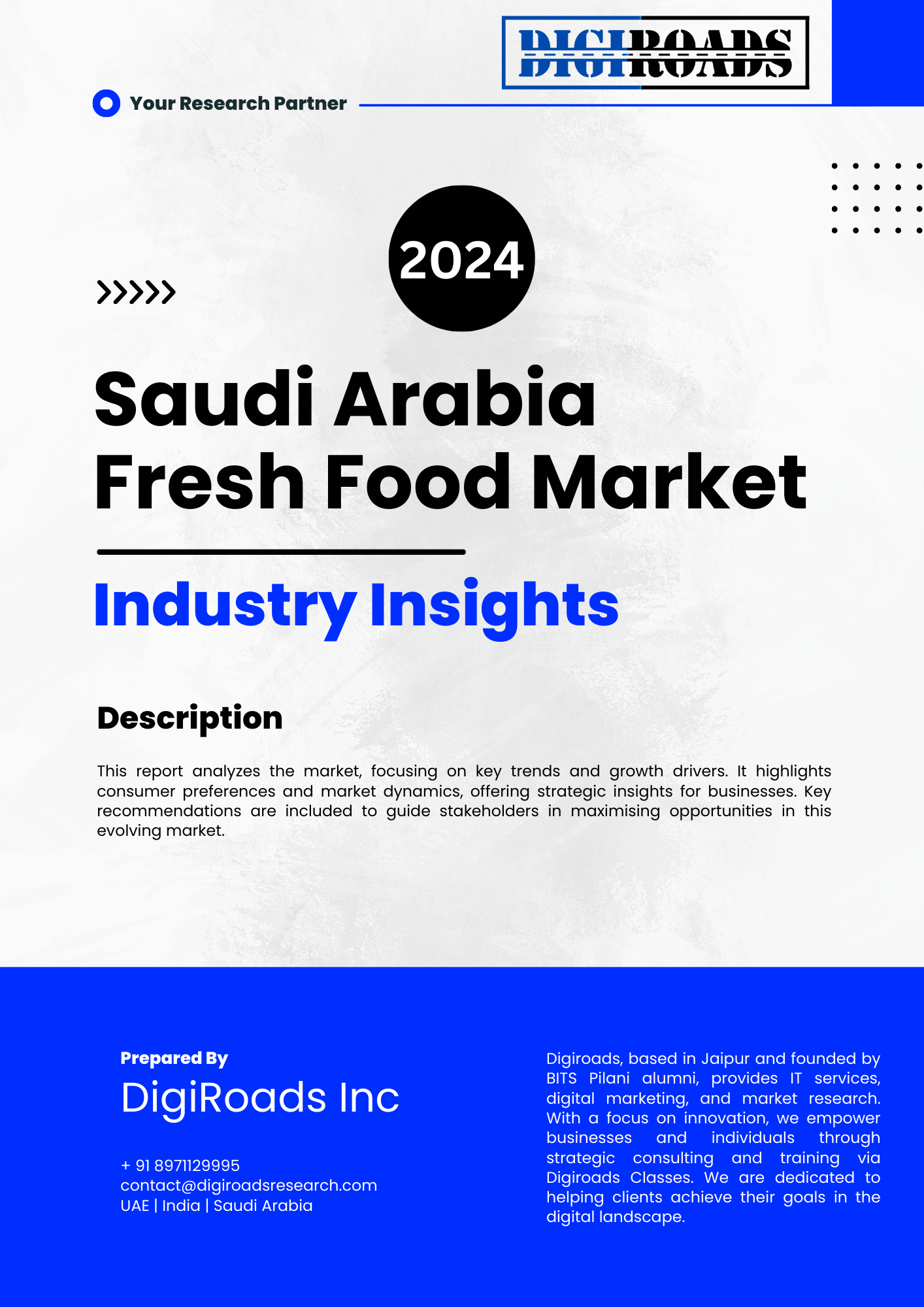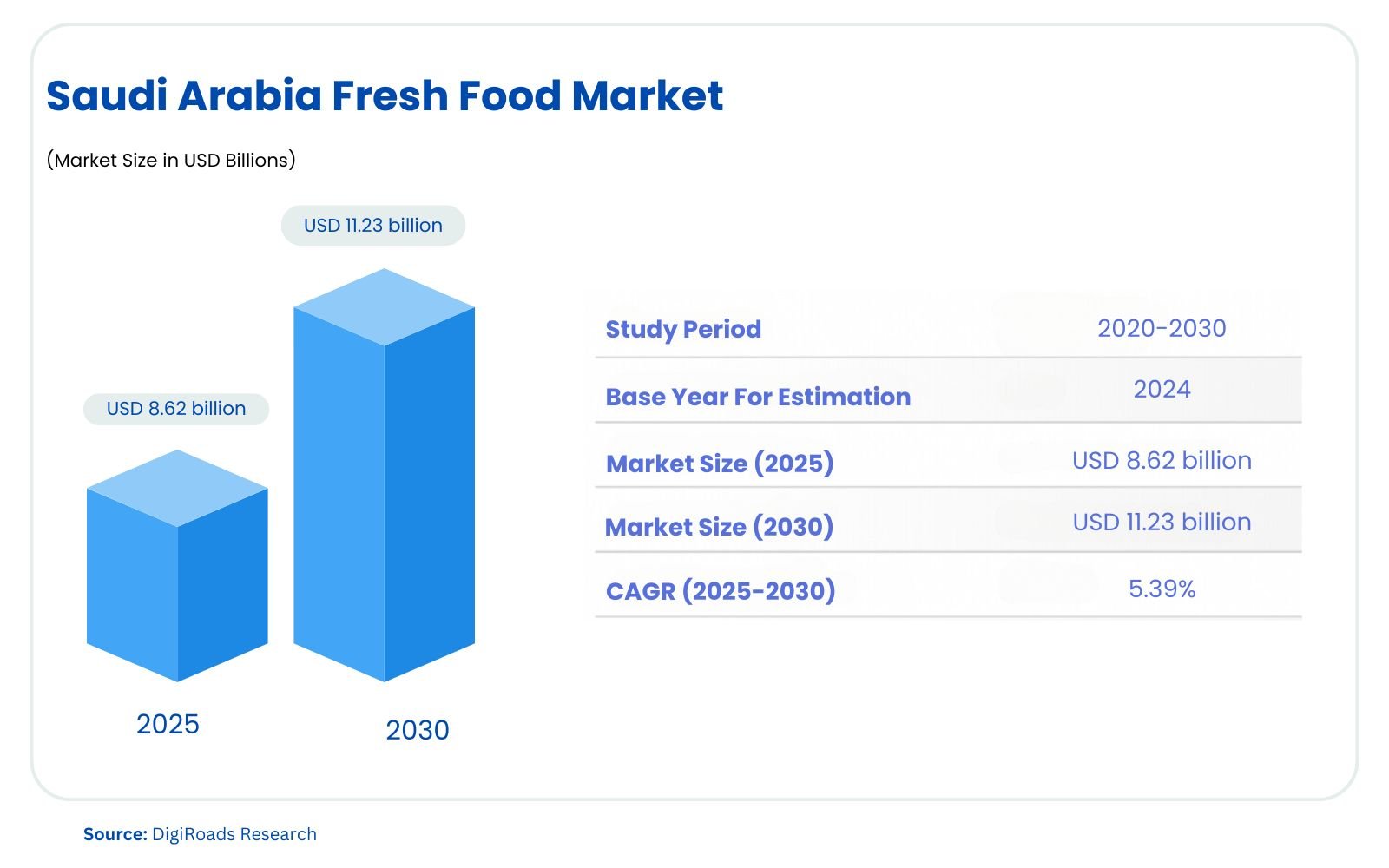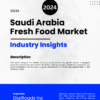No products in the cart.
Saudi Arabia Fresh Food Market
- Brand: DigiRoads
Discover the 100+ page report on the Saudi Arabia Fresh Food Market, providing insights into trends, growth drivers, and the competitive landscape. Available in PDF and Excel formats for easy access to detailed data and analysis.
Category: Food and Beverage
Brand: DigiRoads
Saudi Arabia Fresh Food Market Report | Market Size, Industry Analysis, Growth Opportunities, & Forecast (2025-2030)
Saudi Arabia Fresh Food Market Overview
The Saudi Arabia Fresh Food Market is poised for significant growth, driven by changing consumer preferences, increasing health consciousness, and government initiatives. The Saudi Arabia Fresh Food Market is on a growth trajectory, with an estimated market size of USD 8.62 billion in 2025, and is projected to reach USD 11.23 billion by 2030, expanding at a CAGR of 5.39% during the forecast period 2025-2030. The demand for fresh fruits and vegetables has surged due to rising awareness of the health benefits of natural and chemical-free produce. The government has invested heavily in enhancing food security, adopting modern agricultural technologies such as greenhouse farming and drip irrigation, ensuring year-round produce availability despite the arid climate.
Additionally, the market is witnessing a shift toward organic and locally grown products as consumers demand more sustainable and nutritious options. Dates, watermelons, and citrus fruits are the primary products, while innovations in farming and distribution continue to enhance quality and efficiency. The report analyzes the market by production volume, consumption, imports, and exports, along with price trends. It also highlights the challenges faced, such as unfavorable climatic conditions and the high cost of entry.
This comprehensive report provides insights into key market drivers, restraints, and future opportunities in Saudi Arabia’s fresh food market.
Market Report Coverage:
The “Saudi Arabia Fresh Food Market Report—Future (2025-2030)” by Digiroads Research & Consulting covers an in-depth analysis of the following segments in the market.
| Fruits | Includes fresh fruits like dates, watermelons, pomegranates, citrus, and grapes. |
| Vegetables | Includes fresh vegetables such as tomatoes, cucumbers, onions, and potatoes. |
| Organic and Locally Produced | Focuses on organic and locally grown produce, which is gaining popularity among consumers. |
Study Assumptions and Definitions
This report on the Saudi Arabia Fresh Food Market (2025-2030) is based on several key assumptions to ensure accurate market forecasting and analysis:
- Market Scope: The scope of the study is limited to fresh fruits and vegetables, which are consumed in their natural, unprocessed form. The focus is on domestically produced and imported fresh food products, excluding processed or frozen foods.
- Data Sources: Market data is derived from industry reports, government publications, agricultural surveys, and interviews with key industry players. Projections for 2025-2030 are based on current trends and historical data.
- Market Segmentation: The market is segmented into fruits, vegetables, organic produce, and locally grown products. This segmentation considers the consumption patterns, market demand, and trade activities, including imports and exports of fresh produce.
- CAGR Assumption: The market growth rate is assumed to follow a compound annual growth rate (CAGR) of 5.39% from 2025 to 2030, based on factors such as increasing health consciousness, government policies supporting food security, and technological advancements in agriculture.
- Government Policies and Technological Impact: This report assumes that the Saudi government’s ongoing investments in food security, greenhouse farming, and agricultural technologies will continue to drive market growth and production capacity throughout the forecast period.
Market Scope
The scope of this report focuses on the Saudi Arabia Fresh Food Market, specifically covering fresh fruits and vegetables that are grown domestically or imported. This includes all varieties of fresh produce consumed in their natural form, excluding processed, packaged, or frozen foods. The report provides a detailed analysis of the market, including production volumes, consumption patterns, trade activities (import and export), and price trends. Key segments covered include fruits (such as dates, citrus, pomegranates, and grapes) and vegetables (such as tomatoes, cucumbers, onions, and potatoes). The scope also extends to organic and locally produced fruits and vegetables, which are increasingly in demand due to health-conscious consumer behavior.
The report forecasts market trends, growth potential, and emerging opportunities, with a focus on the 2025-2030 period. Additionally, it analyzes government policies, technological advancements in agriculture, and the role of greenhouse farming, which are expected to significantly impact market dynamics during this time frame.
MARKET OUTLOOK
Executive Summary
The Saudi Arabia Fresh Food Market, encompassing fresh fruits and vegetables, is poised for significant growth from 2025 to 2030, with an estimated market size of USD 8.62 billion in 2025 to USD 11.23 billion by 2030, with a CAGR of 5.39%. The market is driven by a combination of rising domestic demand, government support for agricultural development, and technological advancements, such as greenhouse farming and modern irrigation systems, which enable year-round cultivation despite the region’s challenging climate.
Key trends include a growing demand for organic and locally produced fresh food, as consumers become more health-conscious and seek products free from synthetic chemicals and pesticides. The Saudi government plays a crucial role in fostering this growth through policies, subsidies, and initiatives like the National Agriculture Development Program, aimed at improving food security and boosting domestic production.
Dates, a vital crop in Saudi Arabia, dominate the fresh fruit sector, with the country being the world’s largest exporter of dates. Other significant fruits include pomegranates, citrus, and grapes, while vegetables like tomatoes, cucumbers, onions, and potatoes are essential to the market. The government’s ongoing investment in greenhouses and irrigation technologies, particularly through the USD 1 billion initiative for agricultural sector expansion by 2025, is expected to continue fostering growth and sustainability in the sector.
The market faces challenges such as unfavorable climatic conditions and high entry costs for new players, but these are mitigated by technological innovations and favorable government policies. The increasing adoption of greenhouse farming and the focus on sustainable agricultural practices are expected to drive continued market growth throughout the forecast period.
COMPETITIVE LANDSCAPE
The Saudi Arabia Fresh Food Market is moderately fragmented, with regional and multinational players competing fiercely for market share.
Key Market Players
- LULU Group International
- Carrefour
- Spar International
- Abdullah Al-Othaim Markets
- Saudi Marketing Company
Market Share Analysis
The Saudi Arabia Fresh Food Market is characterized by a competitive landscape with key players dominating the retail and distribution channels. The market share is primarily divided between large retail chains, supermarkets, and hypermarkets, which account for a significant portion of fresh food sales. Among the key players, LULU Group International, Carrefour, and Abdullah Al-Othaim Markets are some of the largest contributors, with extensive networks and a robust distribution infrastructure across the country. These retail giants have a large market presence and offer a wide range of fresh fruits and vegetables, both domestically produced and imported, ensuring consistent availability for consumers.
The Saudi Marketing Company also holds a notable market share, leveraging its expertise in the supply of fresh produce. Smaller, specialized retailers and local farms focus on catering to niche segments, such as organic and locally sourced fresh food, which is increasingly gaining traction among health-conscious consumers.
In terms of fresh produce types, dates dominate the fruit sector, with Saudi Arabia being the leading global exporter. Vegetables like tomatoes, cucumbers, and onions hold substantial shares in the vegetable market. The growing demand for organic produce and sustainable farming practices has also led to the emergence of new players focusing on high-quality, chemical-free products, further diversifying the market dynamics. As the market continues to grow, consolidation and strategic partnerships are expected to shape the competitive landscape.
MARKET DYNAMICS
Market Drivers and Key Innovations
The Saudi Arabia Fresh Food Market is experiencing growth due to several key drivers:
- Government Initiatives and Support: The Saudi government has introduced numerous policies and initiatives to enhance food security and boost domestic agricultural production. Programs like the National Agriculture Development Program, which focuses on increasing local production and providing financial incentives to farmers, have been instrumental in driving market growth. Additionally, investments in modern irrigation systems and greenhouse farming are helping overcome the challenges posed by the country’s arid climate.
- Rising Consumer Demand: With the population becoming more health-conscious, there is an increasing demand for fresh, organic, and locally sourced produce. Consumers are prioritizing fresh food options over processed alternatives, leading to a shift in purchasing behavior. The trend towards healthier diets and sustainable eating practices is a major factor contributing to the market’s growth.
- Technological Advancements in Agriculture: Innovations such as hydroponics, vertical farming, and advanced greenhouse technologies have revolutionized the fresh food sector in Saudi Arabia. These technologies not only increase the efficiency of production but also allow for year-round cultivation, ensuring a steady supply of fresh produce despite the harsh climate conditions.
- Sustainability Focus: The rising focus on sustainable agriculture practices is driving innovation in the market. The adoption of eco-friendly farming techniques, organic produce, and reduced carbon footprint are becoming increasingly important to both consumers and producers, fueling demand for sustainably sourced fresh food.
These drivers, along with ongoing innovations, are expected to shape the future of the fresh food market in Saudi Arabia, enhancing both production capabilities and consumer access to quality fresh produce.
Market Challenges
- Unfavorable Climatic Conditions: Saudi Arabia’s arid desert climate presents significant challenges for fresh food production. Limited rainfall and harsh temperatures make it difficult to cultivate crops without advanced irrigation systems and greenhouse technologies. Despite innovations, climate conditions still pose a challenge to ensuring consistent and cost-effective fresh food production.
- High Production Costs: The initial investment required for modern farming technologies such as greenhouses, hydroponics, and advanced irrigation systems is high. Additionally, the costs of maintaining these systems can be a barrier for smaller-scale farmers and producers. These high production costs can lead to higher prices for consumers, affecting market accessibility.
- Dependence on Imports: Despite efforts to increase domestic production, Saudi Arabia still relies heavily on imports for a significant portion of its fresh food needs, particularly fruits and vegetables that are not locally cultivated. This dependency on imports exposes the market to global supply chain disruptions, trade policy changes, and fluctuations in international prices.
- Logistical and Supply Chain Issues: The logistics of distributing fresh food products across a vast desert region can be complex and costly. Maintaining the quality and freshness of produce during transportation and storage remains a challenge, especially for perishable items. Inadequate cold storage and distribution infrastructure can lead to significant losses and inefficiencies.
- Labor Shortages: The agricultural sector in Saudi Arabia faces a shortage of skilled labor, especially for intensive farming practices. While labor is sourced from other regions, the lack of skilled workers in modern farming technologies limits productivity and efficiency.
Market Opportunities
- Growth in Organic and Locally Produced Fresh Food: As consumers become more health-conscious, there is a growing demand for organic, pesticide-free, and locally sourced fresh food products. This presents opportunities for farmers and businesses to invest in organic farming and capitalize on the increasing preference for sustainable and healthy food options.
- Technological Advancements in Farming: Innovations in greenhouse farming, hydroponics, and vertical farming offer opportunities to overcome the limitations of Saudi Arabia’s climate. The adoption of these technologies can significantly increase yield, reduce water usage, and allow for year-round production of fresh fruits and vegetables, addressing the demand for local produce.
- Government Support for Agriculture: The Saudi government’s initiatives, such as the National Agriculture Development Program, aim to enhance domestic food production and ensure food security. This creates opportunities for businesses to benefit from subsidies, loans, and other forms of support designed to boost agricultural productivity.
- Expansion of Cold Chain Infrastructure: Developing cold storage facilities and improving the cold chain logistics for fresh produce is a key opportunity. By enhancing transportation and storage solutions, businesses can ensure the freshness of imported and locally grown produce, reducing losses and improving market availability.
- Increasing Export Potential of Date Production: Saudi Arabia’s dominant position in global date production provides opportunities to further expand exports. Investing in date farming and processing technologies can increase exports and meet the growing international demand for dates and date-based products.
RECENT STRATEGIES & DEVELOPMENTS IN THE MARKET
- Government Investment in Agricultural Infrastructure: In 2023, the Saudi Ministry of Environment, Water, and Agriculture launched the “National Agriculture Development Program,” aiming to boost local food production. The program focuses on sustainable farming practices, modern irrigation systems, and incentivizing farmers with financial support to ensure food security.
- Investment in Greenhouse Farming and Technology: To overcome climate challenges, Saudi Arabia has significantly invested in greenhouse technology. The number of greenhouses in the country has grown rapidly, enhancing the production of high-value crops like tomatoes, cucumbers, and strawberries. As of 2024, the protected cultivation area for vegetables was around 7,000 hectares, reflecting the commitment to sustainable farming.
- Expansion of Cold Chain Logistics: The Saudi Agricultural Development Fund (ADF) announced loans worth over SAR 2 billion (approximately USD 533 million) to support vegetable production in greenhouses and the development of cold storage facilities. This move aims to enhance the shelf life and transportation of fresh produce, reducing wastage and improving market access.
- Date Export Growth: Saudi Arabia became the world’s leading date exporter in 2023, with exports reaching USD 390.1 million. The country now exports to 113 countries and produces around 300 types of dates. The government’s support for the date industry, coupled with modern technologies, has propelled the country’s position as a global leader in date exports.
- Private Sector Participation in Agri-Tech: Private companies have increased their participation in agri-tech innovations, such as vertical farming, hydroponics, and precision agriculture. These technologies are aimed at increasing yields while reducing water consumption, a critical factor given the region’s arid climate.
KEY BENEFITS FOR STAKEHOLDERS
- Improved Market Access: Stakeholders in the fresh food supply chain, including producers, distributors, and retailers, benefit from expanding government initiatives and infrastructural investments, which improve the transportation and distribution of fresh produce. This enables easier access to local and international markets, especially with the development of cold chain logistics and storage facilities.
- Increased Revenue Opportunities: With the rise in demand for fresh, organic, and locally grown produce, stakeholders in agriculture and retail sectors can tap into new consumer trends. By adopting sustainable farming practices and aligning with government-driven programs, stakeholders can position themselves to capitalize on growing market segments like organic fruits, vegetables, and dates.
- Government Support and Incentives: The Saudi government has committed to various subsidies, grants, and loans to support local farmers, particularly in the greenhouse farming sector. Stakeholders, including farmers and agricultural technology providers, can leverage these financial incentives to improve their operations and reduce entry barriers, enhancing profitability.
- Technological Advancements: The adoption of advanced agricultural technologies, such as greenhouse farming, hydroponics, and precision farming, enables stakeholders to increase production efficiency and sustainability. These innovations reduce water consumption, improve crop yields, and mitigate the challenges posed by Saudi Arabia’s arid climate, directly benefiting producers and agritech companies.
- Export Growth Opportunities: Saudi Arabia’s position as a global leader in date exports presents significant benefits to stakeholders involved in the cultivation, processing, and distribution of dates. With increasing international demand, especially in the Middle East, Europe, and Asia, stakeholders can diversify revenue streams by tapping into the growing export market.
At DigiRoads Research, we emphasize reliability by employing robust market estimation and data validation methodologies. Our insights are further enhanced by our proprietary data forecasting model, which projects market growth trends up to 2030. This forward-thinking approach ensures our analysis not only captures the current market landscape but also anticipates future developments, equipping stakeholders with actionable foresight.
We go a step further by offering an exhaustive set of regional and country-level data points, supplemented by over 60 detailed charts at no additional cost. This commitment to transparency and accessibility allows stakeholders to gain a deep understanding of the industry’s structural and operational dynamics. By providing exclusive and hard-to-access data, DigiRoads Research empowers businesses to make informed strategic decisions with confidence.
In essence, our methodology and data delivery foster a collaborative and data-driven decision-making environment, enabling businesses to navigate industry challenges and capitalize on opportunities effectively.
Contact Us For More Inquiry.
Table of Contents
INTRODUCTION
- Market Overview
- Years Considered for Study
- Market Segmentation
- Study Assumptions and Definitions
- Market Scope
RESEARCH METHODOLOGY
MARKET OUTLOOK
- Executive Summary
- Market Snapshot
- Market Segments
- Fruits:
- Includes fresh fruits like dates, watermelons, pomegranates, citrus, and grapes.
- Vegetables:
- Includes fresh vegetables such as tomatoes, cucumbers, onions, and potatoes.
- Organic and Locally Produced:
- Focuses on organic and locally grown produce, which is gaining popularity among consumers.
- Fruits:
COMPETITIVE LANDSCAPE
- Recent Strategies (Key Strategic Moves)
- Market Share Analysis
- Company Profiles
- LULU Group International
- Carrefour
- Spar International
- Abdullah Al-Othaim Markets
- Saudi Marketing Company
MARKET DYNAMICS
- Market Drivers
- Market Challenges
- Market Opportunities
- Porter’s Five Forces’ Analysis
- Bargaining Power of Suppliers
- Bargaining Power of Buyers
- Threat of New Entrant
- Threat of Substitutes
- Competitive Rivalry
GLOSSARY OF PROMINENT SECONDARY SOURCES
DISCLAIMER
ABOUT US



